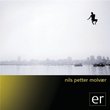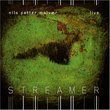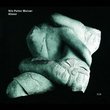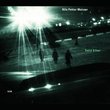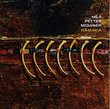| All Artists: Nils Petter Molvaer Title: Re-Vision Members Wishing: 2 Total Copies: 0 Label: Emarcy Import Original Release Date: 1/1/2008 Re-Release Date: 4/25/2008 Album Type: Import Genres: Jazz, Pop, Classical Style: Number of Discs: 1 SwapaCD Credits: 1 UPC: 602517634466 |
Search - Nils Petter Molvaer :: Re-Vision
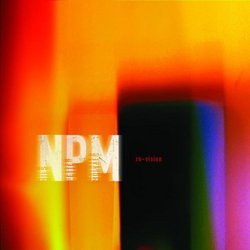 | Nils Petter Molvaer Re-Vision Genres: Jazz, Pop, Classical
|
Larger Image |
CD DetailsSimilar CDs
|
CD ReviewsRe-Vision by Nils Petter Molvær, Sources, Intentions, Revisi Nitya Nadesan | Mercer Island, WA United States | 06/22/2008 (5 out of 5 stars) "Having scored and recorded for numerous films, Nils Petter Molvær wanted to take the opportunity to present some of this work "outside the box".
In re-vision, we are presented with a selection of what Molvær feels represents his work for film at its most independently listenable, and yet most integrated with the films they are part of. "Listening to these tracks on the album and listening to them in the film contexts are very different experiences." We often forget it's there. We watch events, joyful, sorrowful, peaceful and violent, and we are almost unaware of its presence. The movie soundtrack, or - more properly - score, is a key ingredient of any film. Yet much of the time, its main purpose it to have an effect, but remain invisible. Could a component survive outside the engine? NPM realised that it should, because his compositional techniques meant that something more instinctive was at work. "I always try to keep the music personal. The directors, who have asked me so far, do it because they like the feeling in my music, and they use songs from my albums as "directions" for what they want. However, the movie is the "soloist", so I'm trying to create musical atmospheres, and effects: interesting, sad, angry, or feel good ... or bad. It depends on the script, and the mood or feeling the director (and sometimes the producer) is after. Personally, I prefer to communicate with the director." As a lover of the medium, Molvær is very aware of the highs and lows of scoring for film. "There is a large overspill when you write film music. Sometimes there can be 40-50 ideas, and only 4 or 5 get through." He smiles: "I keep most of the ideas on file, though." The album, re-vision, draws from three different films: Frozen Heart (Dir. Stig Andersen); EDY (dir. Stéphan Guérin-Tillié); Hoppet (Dir. Petter Næss). The moods on the tracks from these three films vary greatly, yet they form a unified vision. re-vision is quite different from Molvær's studio or live material, and it sits in stark contrast to the two previous "Re-" albums, Recoloured and Remakes: it is fluid and atmospheric, moving through textural changes, reloading itself with new emotional energies as it progresses, and yet sustains a unity and coherence, becoming something uniquely "Molvær". It stands as a complete Molvær album, expressing the unique musical vision that has informed his albums from "Khmer" to "ER". The feeling that this album is music for a personal inner film is unshakable, and it makes the listener curious as to future directions in Molvær's music as well as arousing curiosity in relation to the films he has already scored, and films that are yet to come. The re-vision CD artwork is by highly acclaimed British artist, Russell Mills. The images complement the music perfectly, reminding us of the visual origins of much of the music without putting a strictly recognisable dogma in place: the images are as fluid as the music itself, warm, amorphous, and evocative. Molvær has a number of future film scores lined-up. At the moment, he is working on a score for a German film, Hannah's Words. This film requires a slight twist in scoring mechanics in that some of the score is required before shooting. It is challenges such as this that have kept Molvær coming back to film regularly over the past 10 years. When asked about his film preferences for scoring, he replies: "Dramas, Sci-Fi, and Thrillers, most probably. I particularly enjoy darkly comic movies, though." He laughs again: "I guess, though, I won't be at the top of any director's list to score a romantic comedy!" re-vision: Track-by-Track The album begins with Torn, from Hoppet, featuring the voice of Nizamettin Aric. It is a dramatic beginning, and is an appropriate choice to lead us into this deeper region of the Molvær catalog. The Beginning, from EDY is a melodic, uplifting piece, carrying further World music elements through a steadily evolving musical trip. Alone in the Bathtub - also from EDY - is an extended meditative piece, pulsing steadily, yet rippling and undulating. Visitation, from Hoppet, has NPM diversifying in a way previously unheard, replacing his trumpet with the Armenian duduk: the effect is startling, haunting and evocative. Arctic Dub, from Frozen Heart, is perhaps the track that most Molvær fans will find easiest to relate to as it could easily slip unnoticed into Solid Ether or np3, delivering the kind of dub beat and bassline that underpinned many of the tracks on those albums. Perimeters, a co-composition with Jan Bang, delivers more of the World music elements that have been present in Molvær's work since Khmer, the beats and drones providing a surface for Molvær's inimitable trumpet to etch into. Trumpet Player in the Backyard, from EDY, delivers a beautiful solo trumpet performance from Molvær, a piece that is like a narrative, giving more than just a series of notes held together by pure emotional intensity or pure intelligence, creating a sense of spirituality that leads into the subsequent The End, also from EDY. The End marks a handshake moment between np3 and ER, as the track is infused with the dynamic flavours of both. The remainder of the album is given over to tracks from Hoppet. The Visitor, Azad's Theme and Decisions are short pieces, gradually evolving from atmospherics, whispers, and hints, through to the full melancholic melody of Decisions: surprisingly powerful given their brevity. The final track, Leaps and Bounds, marks a circular return to the opening of the album, with Nizamettin Aric's superb vocals guiding us into the most highly charged track on the album. The buildup is tense, but the tension never breaks, instead being sustained through changes in percussion and harmonic trumpet until Nizamettin Aric returns, heralding an increase in tension that snaps and falls into a dreamlike ending that segues into the distance." |

 Track Listings (13) - Disc #1
Track Listings (13) - Disc #1